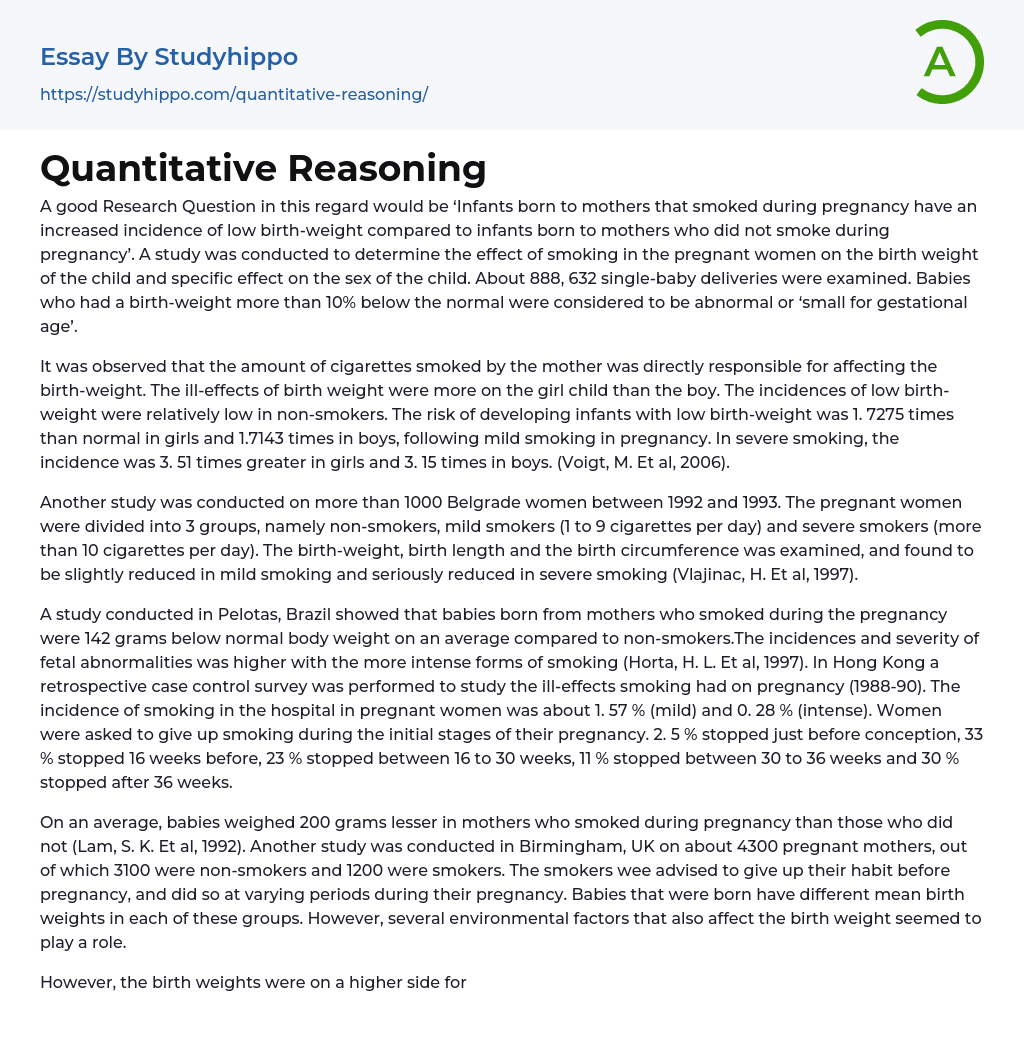Researchers conducted a study on the effect of maternal smoking during pregnancy on infants' birth weight. They analyzed 888,632 single-baby deliveries to investigate whether babies born to smoking mothers had a greater chance of being underweight compared to those born to non-smoking mothers. The study also examined possible gender-specific impacts of smoking on birth weight.
Babies classified as 'small for gestational age' (defined as having a birth-weight more than 10% below the average) were affected by their mothers' smoking habits. The influence of low birth-weight was more significant in girls compared to boys, and non-smokers had a lower prevalence of this condition. The risk factor for infants with low birth-weight was 1.
According to Voigt et al (2006), the prevalence of asthma increased significantly in girls by 7275 times and boys by 1.7143 times when exposed to mild smoking during pregnanc
...y. However, severe smoking led to a much higher incidence, with girls experiencing a 3.51-fold increase and boys a 3.15-fold increase.
Between 1992 and 1993, a study was conducted on over 1000 Belgrade women to evaluate the impact of smoking during pregnancy. The participants were divided into three groups: non-smokers, mild smokers (1-9 cigarettes per day), and severe smokers (more than 10 cigarettes per day). According to Vlajinac et al. (1997), the study revealed that birth-weight, birth length, and birth circumference were slightly reduced among mild smokers and significantly reduced among severe smokers. Similarly, a study in Pelotas, Brazil found that infants born to smoking mothers had an average weight that was 142 grams lower compared to non-smokers. Additionally, Horta (n.d.) discovered a higher incidence and severity of fetal abnormalities in mothers who smoked heavily.
According to a retrospective
case control survey conducted by Et al in 1997, the negative impact of smoking on pregnancy (1988-90) was examined in Hong Kong. The study revealed that approximately 1.57% of pregnant women at the hospital were classified as mild smokers, while 0.28% were identified as heavy smokers. These women were strongly advised to stop smoking during the early stages of pregnancy.
According to a study conducted by Lam, S. K. et al (1992), the results showed that 2.5% of women quit smoking right before conception, while 33% stopped smoking 16 weeks prior to conception. In addition, 23% of women ceased smoking between 16 and 30 weeks into their pregnancy, followed by 11% who quit between 30 and 36 weeks. Furthermore, it was observed that after completing their first trimester, about 30% of women stopped smoking.
The study also found that babies born to mothers who smoked during pregnancy had an average weight reduction of approximately 200 grams compared to babies whose mothers did not smoke.
A study conducted in Birmingham, UK involved approximately 4300 pregnant mothers. Of these, 3100 were non-smokers and 1200 were smokers who had been advised to quit smoking before becoming pregnant. The smokers quit at different points during their pregnancy. The average birth weights differed between the two groups. Additionally, it was noted that various environmental factors influencing birth weight also appeared to have an effect.
According to MacArthur (1988), babies born to women who stopped smoking earlier during pregnancy had higher birth weights compared to those of women who continued smoking. The average birth weights for babies born to women who quit smoking in the 6th and 16th week of pregnancy were 217 grams
and 213 grams, respectively. However, women who quit smoking after the 16th week had babies with average weights in the middle category. This suggests that pregnant smokers have a higher likelihood of having babies with lower birth weights than non-smokers, and the duration and intensity of smoking directly impact this outcome.
- Tobacco Smoking essays
- Effects Of Smoking essays
- American Dream essays
- Barriers To Entry essays
- Capitalism essays
- Central Bank essays
- Compensation essays
- Consumerism essays
- Economic Development essays
- Economic Growth essays
- Economic Inequality essays
- Economic System essays
- Economy essays
- Employment essays
- Export essays
- Finance essays
- Free Trade essays
- Gross Domestic Product essays
- Human Development essays
- Income Inequality essays
- Industry essays
- Inflation essays
- International Business essays
- International Trade essays
- Macroeconomics essays
- Materialism essays
- Max Weber essays
- Microeconomics essays
- Minimum Wage essays
- Monetary Policy essays
- Monopoly essays
- Pricing essays
- Profit essays
- Recession essays
- resources essays
- Taxation essays
- Trade essays
- Unemployment essays
- Warehouse essays
- World economy essays
- Apoptosis essays
- Asthma essays
- Black Death essays
- Breast Cancer essays
- Cholesterol essays
- Chronic essays
- Chronic Pain essays
- Death essays
- Diabetes essays
- Down Syndrome essays




